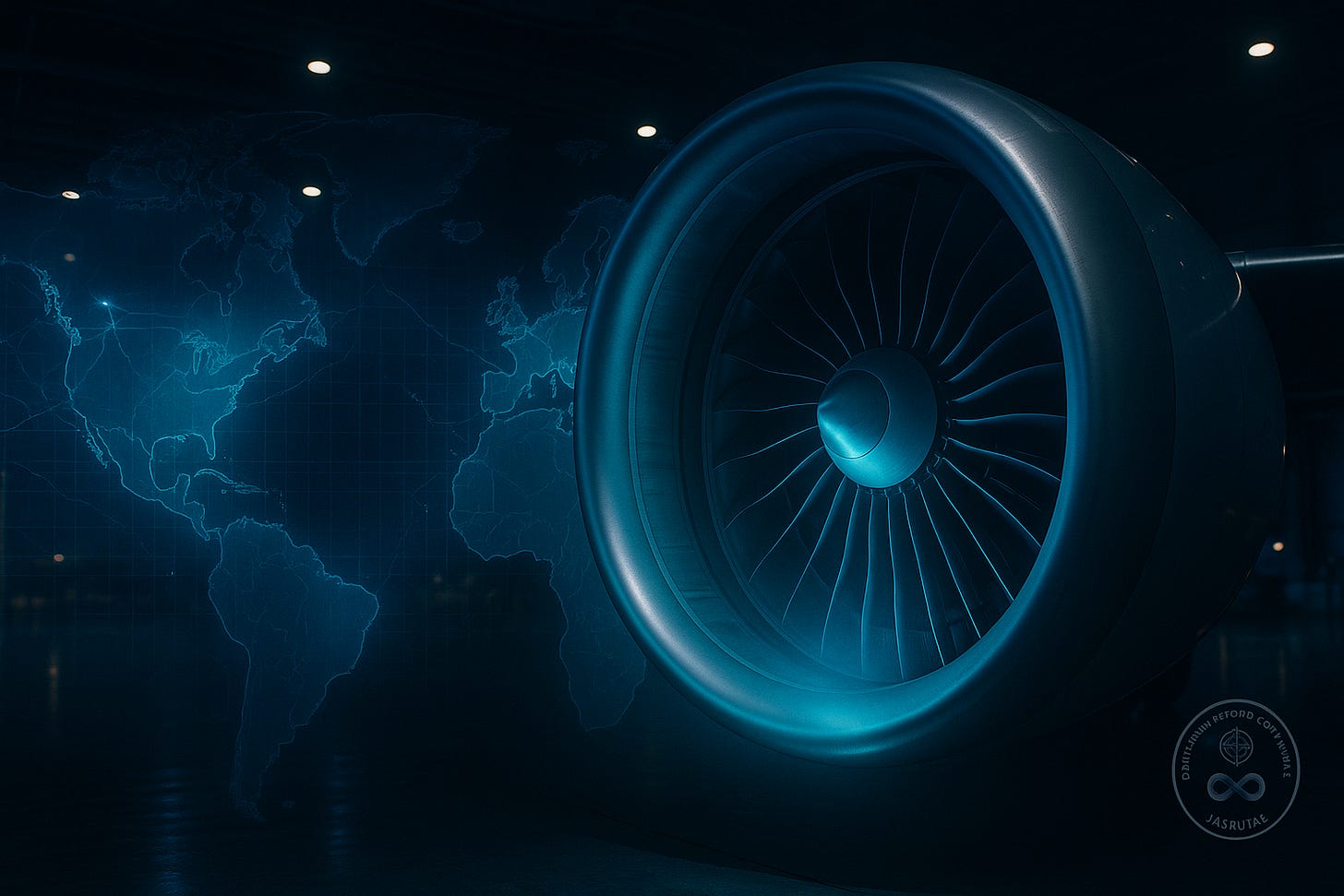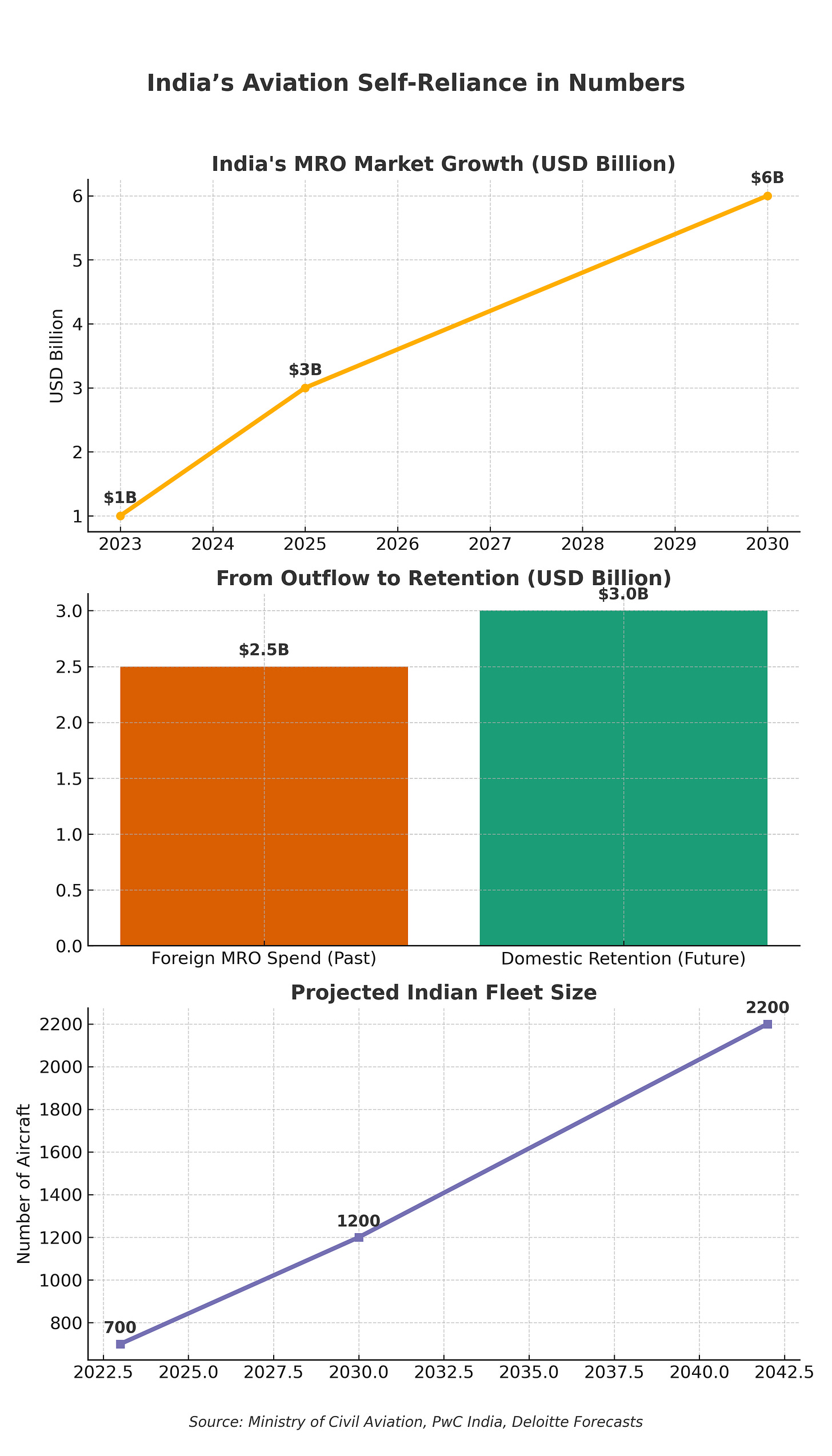✈️ Engines of Self-Reliance: How India’s Aviation Overhaul Quietly Reshapes Global Power
From hangars to world order: How Atmanirbhar Bharat in aviation is tilting the balance of influence.
🌌 When Skies Whisper Sovereignty: India’s Aviation Overhaul and the New Balance of Power
Look up. The roar of a jet over Indian skies may sound like routine air traffic. But listen closely, and it carries something more profound: the hum of a nation shifting from dependence to self-reliance.
India is no longer satisfied with simply flying aircraft. It is learning to maintain, repair, and power them at home. What appears to be a technical story about industrial competence is, in truth, the embodiment of Atmanirbhar Bharat—a movement twinned with Make in India that is quietly redrawing the boundaries of sovereignty in the 21st century.
📈 A Market in Ascent
India’s Maintenance, Repair, and Overhaul (MRO) market was valued at just $1 billion in 2023. According to PwC India, it is projected to reach $3 billion by 2025 and $6 billion by 2030. Meanwhile, India’s commercial fleet is expected to grow to more than 2,200 aircraft by 2042 (Ministry of Civil Aviation).
This is not merely about growth rates or market size. Every billion dollars captured domestically is a sovereign dividend—capital once drained abroad, now recycled into skills, jobs, and infrastructure at home.
(India’s Maintenance, Repair & Overhaul (MRO — the set of services that keep aircraft airworthy, from engine checks to structural repairs) market was valued at just $1 billion in 2023)
👉 Video credit: Aeroclass Lessons
💰 From Outflow to Retention
For decades, Indian carriers funneled $2–3 billion annually to overseas MRO hubs. That flow is now reversing.
The shift is more than financial efficiency. In an era of fragile supply chains and geopolitical uncertainty, retaining aviation autonomy is a strategic insurance policy.
🏗️ Infrastructure as Strategy
MRO hubs are more than buildings. They are nodes of capability—integrating logistics corridors, skilled engineers, spare parts ecosystems, and training institutes. Each hangar that opens in Hyderabad, Bengaluru, or Nagpur is not just a workplace; it is a fortress of resilience.
Here, Atmanirbhar Bharat meets Make in India. Together, they transform India from a client dependent on foreign providers into a service hub that can compete globally. Policy reforms like reducing GST on MRO services from 18% to 5% and easing import duties have catalyzed this change. In just three years, India’s MRO activity surged from ₹800 crore to ₹2,000 crore.
🔥 Jet Engines: The Beating Heart of Sovereignty
If MRO sustains flight, engines command the skies. For decades, India’s inability to design and manufacture reliable jet engines was a glaring vulnerability. The Kaveri project, long stalled, became a symbol of dependency.
Now, partnerships with Safran (France) and GE Aviation (U.S.) have injected new life. These collaborations are not just about turbines and thrust; they are about diplomatic recalibration. Whoever controls the engine controls more than aviation—they control autonomy in defense, deterrence, and negotiation.
Every step toward indigenous propulsion reduces the risk of sanctions, export controls, or grounded fleets. Engines are no longer technical projects; they are statements of sovereignty.
🌍 A Global Chessboard in Motion
The global MRO market is projected by Deloitte to reach $156 billion by 2035. India’s ambition is to secure a 3–5% share—a slice worth $7–10 billion.
At first glance, that seems modest. But in geopolitics, even incremental slices can shift balances. India’s rise as an aviation hub hedges Indo-Pacific risk, challenges Middle Eastern dominance, and cements its role as a partner Western powers can no longer overlook.
🤔 Reflection: Numbers that Whisper Strategy
The numbers in India’s aviation story may look like projections and forecasts, but they carry deeper meaning:
$2–3 billion saved annually becomes a silent defense budget booster.
2,200 aircraft by 2042 becomes a guarantee of resilience.
3–5% of global MRO share becomes leverage in international negotiations.
Revived engine programs become deterrence disguised as technology.
💡 Takeaway: Atmanirbhar Bharat in the Skies
Atmanirbhar Bharat in aviation is not about isolation. It is about interdependence on India’s terms.
Every aircraft serviced domestically is one less vulnerability.
Every engine built here is one more bargaining chip at the diplomatic table.
Every hangar constructed is a bolt tightened on sovereignty.
The skies above India no longer merely carry passengers. They carry a message: power today is measured not only in armies or oceans, but in who keeps the engines running.
And India is making sure it is no longer waiting in line. It is becoming a provider.




